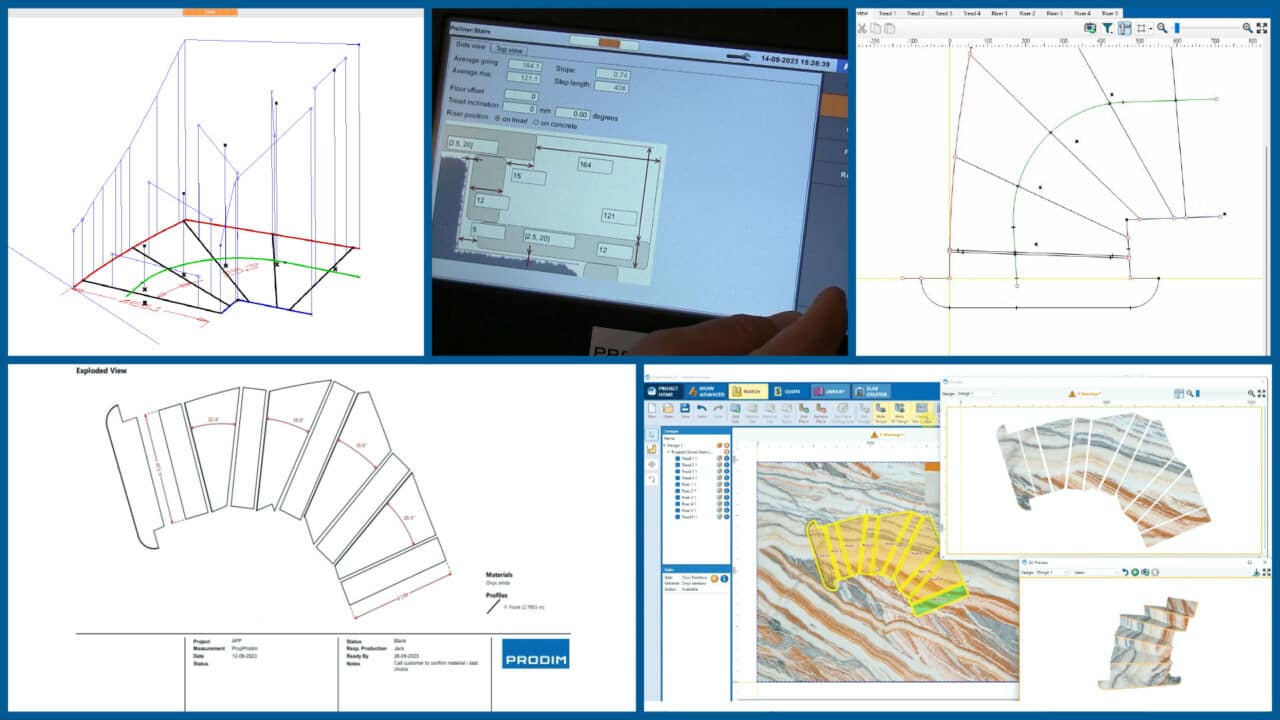
Trends in Stair Design in 2024
Staircases have transcended their functional role, becoming architectural focal points that contribute significantly to the aesthetics of a space. In the realm of interior design, stairs are no longer just a means of transitioning between levels; they are statement pieces that reflect creativity, innovation, and contemporary trends. The technology used in the process of stair design and fabrication is also advanced. Let’s explore the latest trends in stair design that are reshaping the way we ascend in style.
- Increased Usage of Digital Templating and Cladding
In the realm of stone stair design and fabrication, digital templating has revolutionized the way measurements are taken, ensuring unparalleled precision and efficiency. Using tools like the Proliner, digital templating allows designers and manufacturers to capture accurate measurements of staircases with incredible detail. Furthermore, the Proliner Stairs solution simplifies the measuring and editing of staircases to be cladded. Each component is precisely tailored for a perfect, visually striking result.
- Minimalistic Floating Stairs: Defying Gravity with Elegance
Floating stairs have gained immense popularity for their sleek and minimalist design. These stairs create the illusion of floating in mid-air, enhancing the sense of openness and modernity in a space. Typically devoid of risers and relying on hidden structural support, floating stairs showcase clean lines and emphasize the beauty of simplicity.
- Open Riser and Glass Railings: Transparency and Light
Open riser stairs and glass railings continue to be in vogue, emphasizing transparency and allowing natural light to flow through the space. This design choice not only enhances the feeling of openness but also creates a visually light and airy atmosphere. Glass, in particular, lends a contemporary and sophisticated touch to staircases.
- Organic and Curved Designs
The trend towards organic and curved stair designs is making waves in contemporary interiors. These designs break away from the traditional straight lines, introducing fluidity and movement. Whether through helical, spiral, or freeform designs, curved stairs add a dynamic and sculptural element to a space, turning the staircase into a work of art.
- Sustainable Stair Design: Eco-Friendly Choices
As sustainability becomes a central theme in design, staircases are following suit. Sustainable materials, such as reclaimed wood or bamboo, are being used to craft eco-friendly stairs. Additionally, designs that maximize natural light and ventilation contribute to energy efficiency, aligning with the broader trend toward environmentally conscious living.
- Mixed Materials for Texture and Contrast
Staircases are now incorporating a mix of materials to add texture and visual interest. Combining materials such as wood, glass, metal, and even stone can create a striking contrast, making the staircase a focal point. Wood treads paired with metal or glass railings, for example, contribute to a harmonious blend of warmth and modernity.
- Smart Stairs: Integrating Technology
In the era of smart homes, stairs are not exempt from technological integration. LED lighting incorporated into the stairs, motion sensors for step illumination, or even smart railing systems with integrated touch controls are becoming increasingly popular. These tech-savvy features not only enhance safety but also contribute to the overall modern aesthetic.
- Elegant Monochromatic Stairs
Monochromatic color schemes are making a comeback in stair design, with stairs seamlessly blending into their surroundings. From all-white staircases to those in varying shades of grey or black, monochromatic designs exude sophistication and create a sense of continuity within a space.
- Cantilevered Stairs: Engineering Marvels
Cantilevered stairs, where treads appear to float without visible support, are capturing the imagination of designers and homeowners alike. This architectural feat not only adds a sense of drama to the staircase but also showcases the advancements in structural engineering that allow for seemingly gravity-defying designs.
- Incorporating Storage: Functionality Meets Design
Maximizing space is a perennial challenge in interior design, and staircases are increasingly being leveraged as opportunities for additional storage. Under-stair drawers, cubbies, or even built-in shelving units are popular choices, seamlessly blending functionality with design.
- Artistic and Customized Railings: A Personal Touch
and artistic railings, whether crafted from metal, glass, or other materials, allow homeowners to express their personal style. Intricate patterns, geometric shapes, or even personalized artwork can transform a staircase into a unique and memorable focal point.
In conclusion, stair design has evolved from a utilitarian necessity to a key element in shaping the aesthetics of a space. The latest trends embrace a wide range of styles, from the sleek and modern to the organic and sculptural. As digital templating technology, sustainability, and individual expression continue to influence design choices, staircases will undoubtedly remain at the forefront of architectural innovation, providing a canvas for creativity and functional elegance in our homes and spaces.
Contact us for tailored advice.



